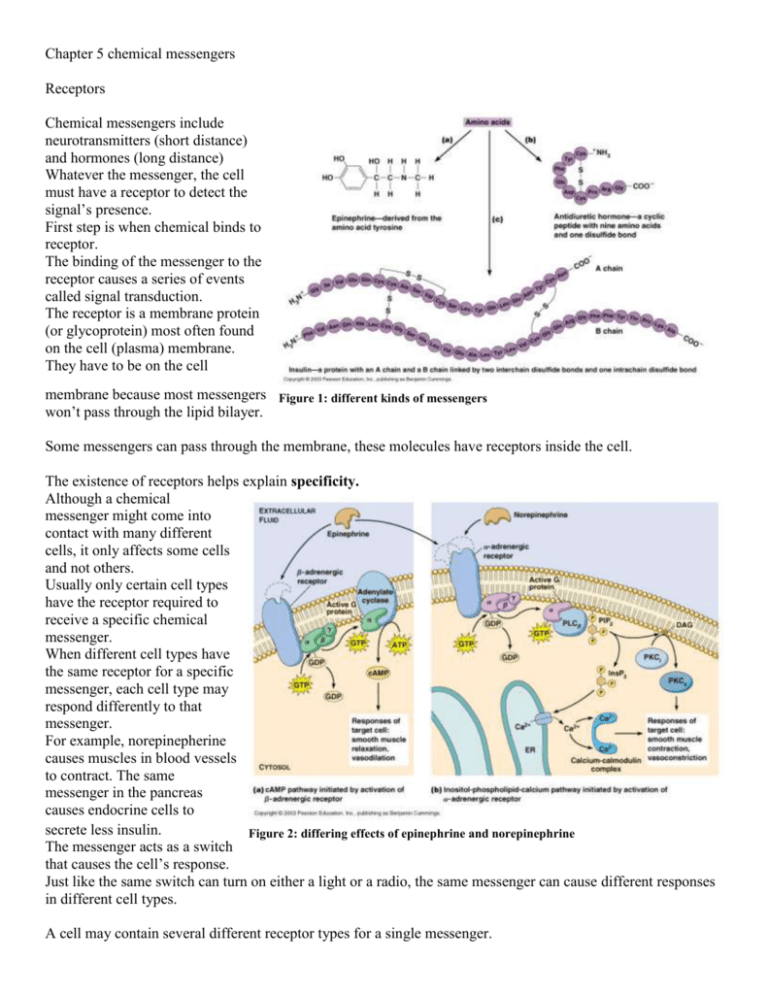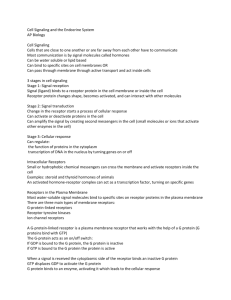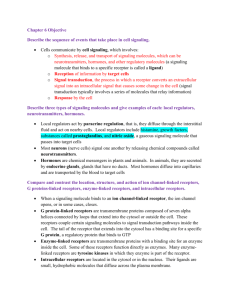Chapter 5 chemical messengers notes
advertisement

Chapter 5 chemical messengers Receptors Chemical messengers include neurotransmitters (short distance) and hormones (long distance) Whatever the messenger, the cell must have a receptor to detect the signal’s presence. First step is when chemical binds to receptor. The binding of the messenger to the receptor causes a series of events called signal transduction. The receptor is a membrane protein (or glycoprotein) most often found on the cell (plasma) membrane. They have to be on the cell membrane because most messengers Figure 1: different kinds of messengers won’t pass through the lipid bilayer. Some messengers can pass through the membrane, these molecules have receptors inside the cell. The existence of receptors helps explain specificity. Although a chemical messenger might come into contact with many different cells, it only affects some cells and not others. Usually only certain cell types have the receptor required to receive a specific chemical messenger. When different cell types have the same receptor for a specific messenger, each cell type may respond differently to that messenger. For example, norepinepherine causes muscles in blood vessels to contract. The same messenger in the pancreas causes endocrine cells to secrete less insulin. Figure 2: differing effects of epinephrine and norepinephrine The messenger acts as a switch that causes the cell’s response. Just like the same switch can turn on either a light or a radio, the same messenger can cause different responses in different cell types. A cell may contain several different receptor types for a single messenger. When the messenger binds with the receptor, it may produce a different response from the same messenger. Sometimes this response is the opposite with the same messenger. For example, the muscles of blood vessels have two receptors for epinephrine. The hormone can cause either contraction or relaxation of the muscle depending on how many receptors of each type are bound to messengers. The degree to which the molecules of a particular messenger bind to different receptor types in the same cell is determined by the affinity of the different receptor types for the messenger. A single cell may have many different receptors for many different chemical messengers. Saturation – a cell’s response to a messenger increases as the concentration of the messenger increases because the number of receptors occupied by messenger molecules increases. Competition – the ability of different messenger molecules that are very similar in structure to compete with each other for a receptor. For example, if a doctor wants to interfere with the action of a particular messenger, they can give a molecule that is similar to the messenger that will bind with the receptor. This blocks the messenger, but doesn’t stimulate the cell’s response. These drugs are called antagonists. Beta Blockers are examples of antagonists used to treat high blood pressure. Antihistamines are another example. Some competitors do stimulate the cell’s response when they bind with the receptor. These drugs are called agonists. Ephedrine (a nasal decongestant) is used to bind to receptors that cause muscles in blood vessels to contract (like epinephrine does) this causes vasoconstriction in nasal passages and fewer sniffles. Regulation of receptors The number of receptors a cell has can be increased or decreased in some cell types. Down Regulation- when a high concentration of messengers is maintained for a long time outside the cell, the total number of receptors for that messenger may decrease or down-regulate. Down regulation makes the cell less sensitive to the messenger (it desensitizes it). Up Regulation- is the opposite effect. Cells exposed to very low concentrations of messengers for long periods of time will produce more receptors. This will increase sensitivity for that messenger (the cell is supersensitive). For example, if the nerves to a muscle are cut so that no more neurotransmitter is released to make them contract, then a few days later if a small amount of neurotransmitter is released to the muscle, it will contract. Up regulation and Down regulation are possible because receptors are continuously being broken down and made by the cell. Some receptors act to move into the cell from the cell membrane when they are bound to the messenger (receptor-mediated endocytosis) and are no longer available for future binding. So at high hormone concentrations, the rate of loss of receptors is high and there are less available on the surface to bind to the messenger. This makes the cell less sensitive to the hormone (down regulation). Some diseases can affect the number of receptors available on the cell surface. This can increase or decrease the cell’s response to a specific messenger. For example, Myasthenia gravis is caused by the destruction of skeletal muscle receptors for acetylcholine (a neurotransmitter) that causes muscle contraction. The result is muscle weakness followed by paralysis. Signal Transduction pathways The combination of messenger with receptor causes a change in the shape of the receptor. This is known as receptor activation. This is always the first step in the cell’s response to the messenger. Responses can include changes in: 1. The permeability, transport properties or electrical state of the membrane 2. The cell’s metabolism 3. What the cell secretes 4. The cell’s rate of division 5. The cell’s contractile (contracting or relaxing) activity All of these responses are due to changes in particular cell proteins. For example, nerve cells generate an electrical signal as a result of neurotransmitters changing the shape of ion channels (membrane proteins) that allow Na+ to diffuse into the cell. The rate of glucose secretion from the liver is increased when epinephrine causes increases in the concentration of enzymes involved in glucose synthesis. Muscle contraction results from the altered shape of contractile proteins which is caused by a chemical messenger. The sequence of events between receptor activation and cell response are called signal transduction pathways. The “signal” is the receptor activation. “transduction” is the process by which the stimulus is transformed into a response. How does receptor activation influence proteins inside the cell that are critical to the response but far away from the receptor? There are different signal transduction pathways for messengers that can pass through the membrane (lipid soluble) and for messengers that cannot pass through the membrane (lipid insoluble). Figure 3: summary of signal transduction pathways Lipid Soluble Messenger pathway Lipid soluble messengers (can pass through membranes) include steroid hormones from the gonads (testosterone, estrogen), thyroid (thyroxine) and Vitamin D (a steroid-like molecule). These molecules will pass through the cell membrane, move into the nucleus and bind to a receptor there. The activated receptor will stimulate specific genes to be transcribed (remember that genes code for proteins so when transcription of a gene is started, more of that protein is going to be made). The hormone/receptor complex binds to a specific sequence near a gene on the DNA called a response element. This event increases the gene’s transcription into mRNA. The mRNA goes leaves the nucleus and goes into the cytoplasm or the Rough ER where it is translated by ribosomes. The result is an increase in the concentration of the protein inside the cell or an increase in the amount of protein secreted from the cell. The hormone usually affects more than one gene and thus more than one protein being made. Lipid insoluble messenger pathway These receptors are classified by the signal transduction pathway that they start. 1. 2. 3. 4. Receptors that function as ion channels. Receptors that function as enzymes. Receptors that activate JAK kinase molecules. Receptors that activate G proteins (that act on ion channels or enzymes in the cell membrane). The chemical messengers that bind to the receptor are called first messengers. Second messengers are molecules that enter the cell or are generated in the cytoplasm as a result of the receptor being activated by the first messenger. The second messengers diffuse throughout the cell to serve as chemical relays from the cell membrane to the proteins inside the cell that do the work. Protein kinase is any enzyme that phosphorylates other proteins by transferring a phosphate to them from ATP. The protein (enzyme) that receives the phosphate changes it shape and carries out its function. There are many different protein kinases, each is able to phosphorylate only certain proteins. Many protein kinases are involved in signal transduction pathways. Most pathways involve a series of reactions in which an inactive protein kinase is activated by phosphorylation and then activates another protein kinase. At the end of the sequence, the phosphorylation of key proteins (transport, enzyme, ion channel, contractile protein, etc…) causes the cell’s response to the first messenger. Ion channel receptors Activation of the receptor by the first messenger causes the channel to open. The opening results in an increase in the net diffusion of the ion across the membrane. Remember that ion channels are specific to one type of ion (Na+, K+, Ca+). Figure 4: Ion channel receptor Receptors that act as enzymes These receptors are usually involved in cell differentiation (specialization into a specific type of cell) or cell division. Figure 5: Protein kinase receptors Receptors that act as enzymes are all protein kinases (except for one). The binding of the messenger to the receptor changes the shape of the receptor so that the enzyme portion located on the cytoplasm side of the membrane is activated. This cause autophosphorylation of the receptor molecule (it phosphorylates itself) Then the cytoplasmic side of the receptor acts as a “docking” site for other proteins. These proteins that joined with the receptor then bind with other proteins in a cascade (A process that occurs in successive stages, each of which is dependent on the preceding one, producing a cumulative effect) In each pathway, at some point, they all involve activation of proteins in the cytoplasm by phosphorylation. The end result of all these pathways is the activation of molecules that control the response of the cell to the messenger. Receptors that interact with cytoplasmic JAK kinases These receptors are usually involved in the production of proteins for export. Like receptors that act as enzymes, these receptors also have enzyme activity. However, the receptor itself does not house the enzyme, instead other enzymes bind to the receptor when it binds to the messenger. JAK stands for Just Another Kinase. The binding of the receptor to the messenger causes the JAK kinase to be activated. These JAK kinases phosphorylate proteins involved in transcription. The result of these pathways is the production of new proteins. Receptors that interact with G proteins This is the largest category of receptors including hundreds of distinct protein receptors. Bound to the receptor is a group of proteins located on the inner surface of the plasma membrane called G proteins. The binding of the first messenger to the receptor cause the receptor to change shape. This causes part of the G protein to bind to GTP (similar to ATP). The part that binds to GTP then breaks off the rest of the protein and binds to another membrane protein, either an ion channel or enzyme.







